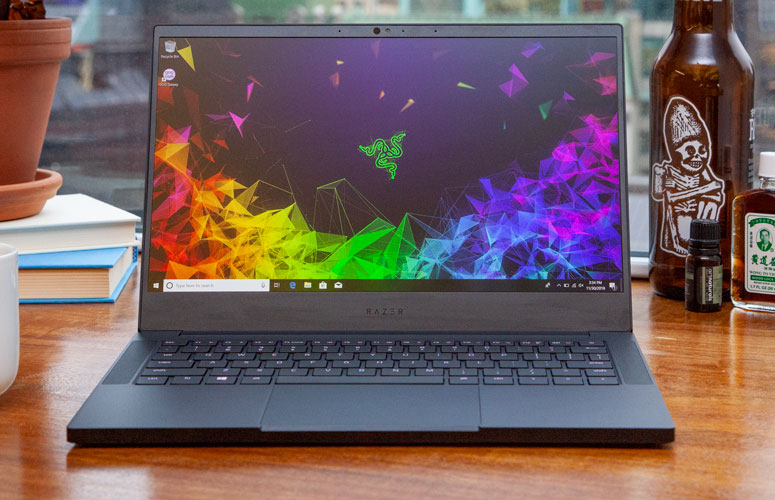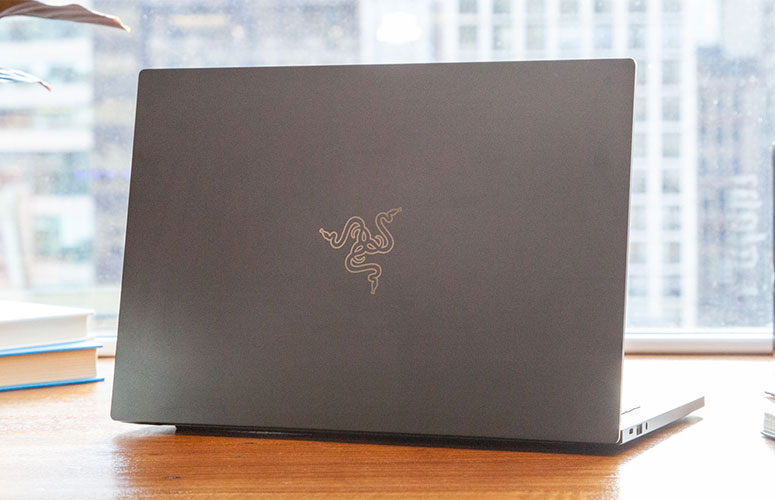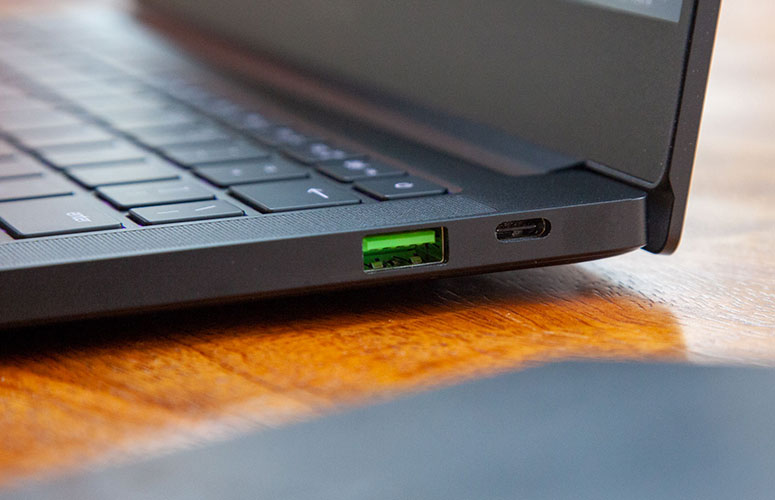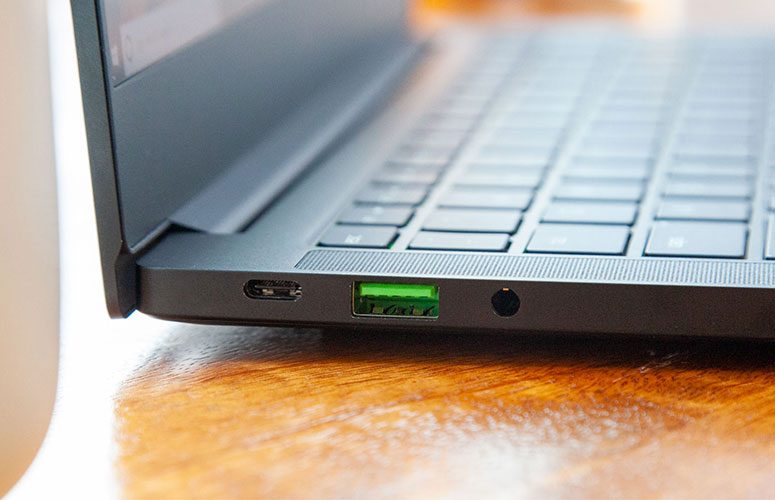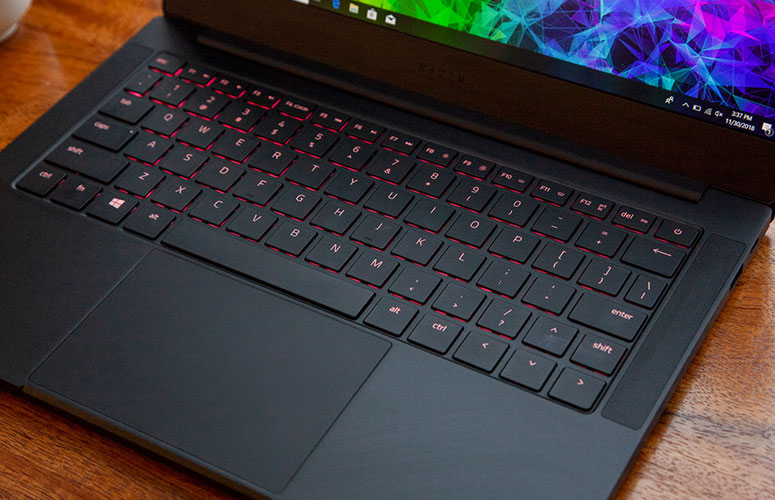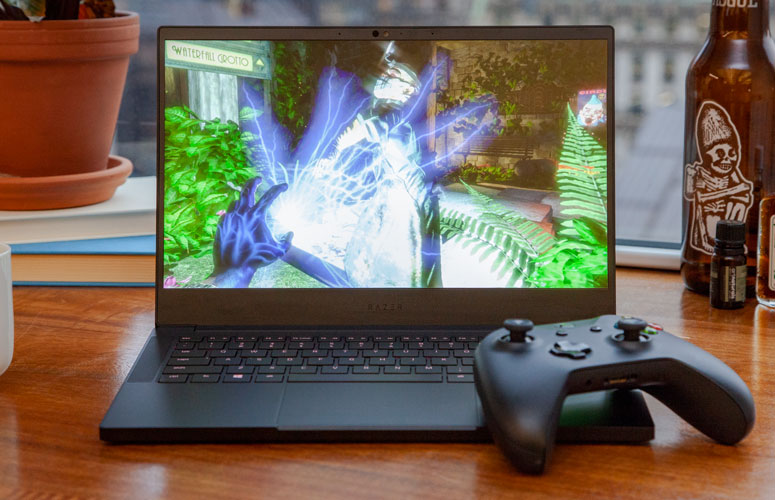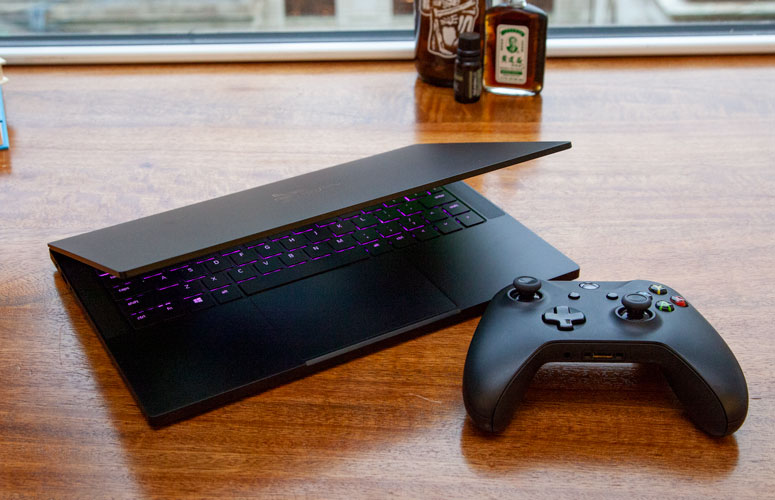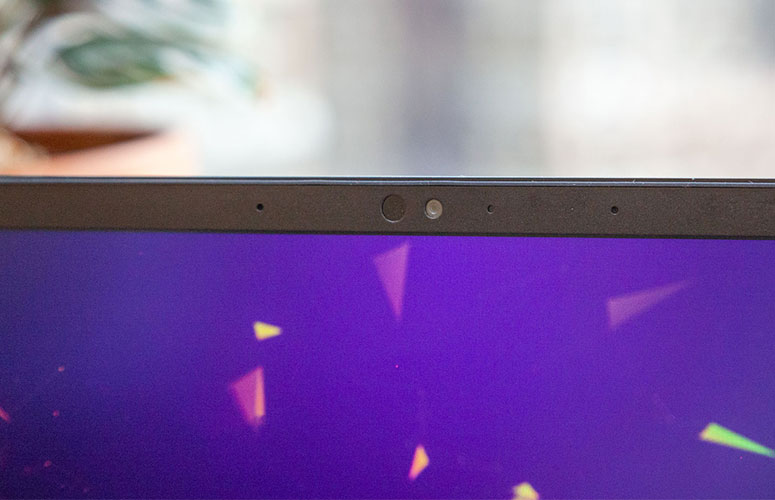Laptop Mag Verdict
With a discrete graphics card and an Intel Whiskey Lake processor, the Razer Blade Stealth is a capable machine for work and play.
Pros
- +
Sleek, attractive design
- +
Powerful overall and graphics performance
- +
Great Audio
- +
Solid battery life
Cons
- -
Undersized keys
- -
Runs hot
Why you can trust Laptop Mag
The new Razer Blade Stealth ($1,599 reviewed, $1,399 starting) has undergone a slight makeover while retaining the sleekness we've come to expect from Razer. But it's what under the hood that's the real crowd pleaser, as this is the first Stealth to ship with discrete Nvidia MX150 graphics. That means that you can play mainstream PC games on the go on a system that weighs less than 3 pounds.
But the shock and awe doesn't stop there. The Stealth is also one of the first laptops shipping with Intel's new Whiskey Lake chip, giving the slim stunner a significant bump in power while lasting over eight hours on a charge. However, an awkward keyboard is the fly in an otherwise tantalizing jar of ointment. Still, the newest version of the Razer Blade Stealth is worth a serious look.
Razer Blade Stealth Price and Configurations
I had fun reviewing the $1,599 model of the Razer Blade Stealth, which has a 1.8-GHz Intel Core i7-8565U CPU with 16GB of RAM, a 256GB PCIe NVMe M.2 SSD, a Nvidia GeForce MX150 GPU with 4GB of VRAM, an Intel UHD Graphics 620 GPU and a 1920 x 1080 display.
If you want to save $200, you can pick up the base mode, l which halves the RAM from 16 to 8GB. But for an additional $300, you can snag a 4K (3840 x 2160) touch panel.
Design
Even though I really miss the glowing Razer logo, I can't deny the unbothered elegance of the new Blade Stealth. The lightly embossed tri-snake logo is subtle, drawing you ever closer to the black aluminum lid to admire its stately beauty. Similar to the Blade 15, the edges of the system are rounded ever so slightly. It's a small detail, but it speaks to the company's meticulousness, which I appreciate.
Sign up to receive The Snapshot, a free special dispatch from Laptop Mag, in your inbox.
More obsidian metal goodness awaits when you open the laptop. The keyboard is floating in a sea of the stuff with a positively gigantic touchpad underneath. On either side is a speaker waiting to pump out the jams. The 13.3-inch display resides up top, ensconced in some decidedly slim bezels. If you flip the laptop over, you'll find a pair of rubber feet running the length of the system's undercarriage, with a pair of vents that offer a generous view of the twin fans.
All that aluminum and a few additional specs put the 12 x 8.3 x 0.6-inch Stealth on the heavier side of the ultraportable scale at 2.9 pounds. It's on a par with the Huawei MateBook X Pro (2.9 pounds, 12 x 8.5 x 0.6 inches). The Dell XPS 13 9370 (12 x 7.9 x 0.5 inches) and Microsoft Surface Laptop 2 (12.1 x 8.8 x 0.6 inches) are slightly lighter at 2.7 pounds.
Ports
Reflecting its relatively slim chassis, the Stealth only has few ports to speak of.
There's a USB 3.1 port (tinted green of course) and a Thunderbolt 3 port on either side.
The only difference is you get a headset jack on the left.
Display
The Stealth's 13.3-inch, 1920 x 1080 screen is bright and vibrant despite its matte, anti-glare coating. When I watched the Captive State trailer, I was impressed at how well the panel captured the richness of actor's Ashton Sanders mahogany skin as well as his faded orange-red hoodie and the ominous metal collar with its various lights around his neck. Detail was clear enough that I saw the tattered material along the sides of the hoodie as well as the distinct braiding of its drawstrings.
Playing Aurion: Legacy of the Kori-Odan was a colorful cavalcade of action. The protagonist's red ceremony garb seemed to radiate off the screen as they unleashed powerful attacks upon their foes. The detail was sharp enough that you could see the wind blowing through their locs.
The Stealth's 13.3-inch, 1920 x 1080 screen is bright and vivacious despite its matte, anti-glare coating.
The display can reproduce 120 percent of the sRGB gamut, just beating the 117-percent achieved by the XPS 13 and the premium laptop average. The MateBook X was only slightly more vivid at 124 percent while the Surface Laptop 2 was hands down the most vivacious at 176 percent.
MORE: Laptops with the Best Display Brightness
When we measured for brightness, the Stealth averaged 346 nits, which is better than the Surface Laptop 2 (321 nits) and the 320-nit average. But the MateBook Pro proved to be the most scintillating at 458 nits.
And a hurrah is definitely in order for the Stealth's bezels, which are getting slimmer with every iteration. In fact, the bezels are 60 percent thinner than its predecessor.
Audio
Itty, bitty speakers, surprisingly big sound. Packing four speakers and a smart amplifier, the Stealth easily filled our test space with Janelle Monae's gender-fluid, afro-futuristic melodies. The snares, hi-hats and bass guitar were nice and clear on "I Like That," providing the perfect backdrop for the artist's lilting soprano and rich alto. But like most laptops this size, it lacked the thump necessary to correct produce the low-end, even with the Dolby Atmos software enabled.
Keyboard and Touchpad
The keyboard on the Razer Blade Stealth is a head-scratcher. I was immediately peeved at the Right Shift, Enter and Backspace keys, which are entirely too short on the island-style keyboard. I would have rather Razer hadn't included the arrow keys than gone with these shrimpy keys that forced me to be a lot more deliberate with my keystrokes. That considerably showed my typing, dropping my final score to 55 words per minute on the 10fastfingers typing test. It's way below my usual 70 wpm.
I usually ding Razer for their shallow keyboards, but the Stealth has just enough pop for a comfortable, springy experience. That 67 grams of actuation is seriously a godsend, considering the keys only have 0.8 millimeters of travel (1.5mm is our minimum).
And like any self-respecting Razer Blade, the Stealth is awash with beautiful Chroma lighting. But this Stealth is a lot more restrained with the light show. Instead of letting you program individual keys with RGB goodness, this version of the Stealth only has one zone, which means that if you change one key's color, you change them all. It's not the technicolor scene I'm used to, but it's still pretty as heck. Besides, you can still program macros and sync the lighting to different games.
The Stealth's 4.3 x 2.8-inch touchpad might not be the biggest I've ever used, but it's in the top ten. The glass Microsoft Precision pad is smooth to the touch, lightning fast and accurate, making it easy to perform three or four-finger swipes along with pinch-zoom.
Gaming and Graphics
The 2018 version of the Razer Blade Stealth is the first to ship with discrete graphics in addition to its integrated Intel UHD Graphics 620 GPU. And although it's only a Nvidia GeForce MX150 GPU, it's still got much more of a graphical punch than prior models. This ystem doubles the amount of VRAM to 4GB, which gives it an edge against other MX GPUs on the market.
But don't start pulling out those AAA titles just yet. The laptop ran older games like Bioshock Infinite and Borderlands 2 like a dream. But on more taxing titles like The Witcher 3: Wild Hunt, low frame rates reduced the action to a stuttering mess. But if you adjust your expectations, the Stealth can be a solid gaming machine in a pinch -- at least until you get back to your Razer Core or Core X.
Still, I was impressed that I could glide around the streets of Gotham in Batman: Arkham Origins at 59 frames per second, just beating bad guys in a whimsical ballet of brutality at 1920 x 1080. When I switched over to Aurion, the hack-and-slash action averaged 62 fps.
On the Dirt 3 benchmark, the Blade churned out an impressed 164 fps, which is more than double the 74-fps average. The MateBook Pro, which has its own MX 150 GPU sat in a distant 117 fps while the Intel UHD 620 GPU-powered XPS 13 and Surface Laptop produced 67 and 82 fps.
I was impressed that I could glide around the streets of Gotham in Batman: Arkham Origins: at 59 frames per second, just beating bad guys in a whimsical ballet of brutality at 1920 x 1080.
Like most gaming laptops, the Stealth switches to its integrated GPU when it's not performing any graphic intensive tasks.
Performance
The Stealth is one of the first laptops to ship with Intel's new Whiskey Lake processors. According to Intel, Whiskey Lake chips are twice as powerful as a 5-year-old Intel CPU. I streamed an episode of Voltron: Legendary Defender on Netflix with 20 additional Google Chrome tabs open, some of which were running Twitch streams, Tweetdeck or YouTube. The Stealth and its 1.8-GHz Intel Core i7-8565U CPU with 16GB of RAM plugged along without a hitch.
The Stealth continued to exhibit its winning ways on our synthetic tests, starting by scoring 15,878 on Geekbench 4, which measures overall performance. It easily beat the 12,285 premium laptop average and sailed past the 14,180 and 12,913 obtained by the XPS 13 and MateBook X, which both have Intel Kaby Lake Core i7-8550U CPUs. The laptop also defeated the Surface Laptop 2 (12,676) and its Intel Core i5-8250U CPU.
There was a stumble on the Excel Spreadsheet test. The Stealth destroyed the 1 minute 35 second average with a time of 21 seconds. It was much faster than the MateBook X (1:49), Surface Laptop 2 (1:15) and the XPS 13 (1:08).
On the File Transfer test, the Stealth's 256GB PCIe NVMe M.2 SSD took 20 seconds to duplicate 4.97GB of mixed-media files for a transfer rate of 254 megabytes per second. It was enough to dispatch the Surface Laptop 2 (203 MBps), which has the same amount of storage. The MateBook Pro (512GB PCIe NVMe SSD) hit 282.7 MBps while the XPS (256GB SSD) notched a blistering 508 MBps.
MORE: Laptops with the Best Overall Performance
During the video transcoding benchmark, the Stealth took 20 minutes and 34 seconds to transcode a 4K video to 1080p, beating the 21:43 average and the MateBook Pro's time of 27:18. However, the Surface Pro and XPS 13 were faster at 17:30 and 16 minutes flat.
Battery Life
Traditionally, the biggest flaw of Razer laptops is the battery life. The last Stealth I reviewed tapped out of our battery test at 5 hours and 21 minutes. And with a discrete graphics card in tow, I had all but written this new Stealth off. I'm elated to say I was very wrong to do so.
The laptop lasted 8 hours and 5 minutes on the Laptop Mag Battery test. It's short of the 8:22 premium laptop average, but not by much. It's a great step forward, but Razer still has a ways to go before it can match the competition. The Surface Laptop 2 and MateBook X had times of 9:22 and 9:55, respectively. The 1080p XPS 13 tapped out at 11:59 while its 4K counterpart clocked in at 8:23.
After playing Aurion for 15 minutes, I measured key locations on the notebook. The touchpad measured 91 degrees Fahrenheit. The middle of the keyboard and undercarriage reached 105 and 108 degrees, respectively. Both temperatures are above our 95-degree comfort threshold. However, I still used the notebook comfortably in my lap.
MORE: Longest Battery Life Laptops
The Stealth still proved to be a hot potato even on our less demanding video streaming test where we stream a fullscreen HD YouTube video for 15 minutes. Once the time elapsed the touchpad hit 95 degrees while the center of the keyboard and bottom reached a hot 104 and 110 degrees.
Webcam
For such a high-quality laptop, I'm surprised that Razer cheaped out on the webcam. The 720p shooter's images were color accurate, reproducing my brown skin and black-and-white sweater.
However, I noticed a lot of fuzziness around the edges, especially my locs, which looked like orangey-brown blobs.
Software and Warranty
Oh ye of little bloatware! Razer employs a light touch when it comes to software. The Synapse software which allows you to customize the lighting, macros, fan speed and screen refresh rate, is the only company-branded software. The notebook also comes with Nvidia's GeForce Experience to help enhance your gaming experience with features such as Battery Boost and Game Optimization.
Thanks to Windows 10, there is a bit of bloat including Netflix, Drawboard PDF, Fitbit Coach and Candy Crush Saga.
The Razer Stealth ships with a one-year limited warranty. See how Razer fared on our annual Tech Support Showdown, Best and Worst Laptop Brands and Best and Worst Gaming Laptop Brands special report.
Bottom Line
With the new Blade Stealth, Razer finally has a firm foothold in premium ultraportable market.
For $1,599, the new Razer Blade Stealth gives you a laptop that sports Intel's new Whiskey Lake processor along with Nvidia discrete graphics, making it one of the most powerful ultraportables on the market. It's got excellent audio and a lovely display that's good for work or play. And Razer's found a way to significantly improve the battery life over past iterations. However, some of the most important keys on the keyboard are woefully undersized, making typing a chore.
You can get the Dell XPS 13 for $1,299, which offers longer battery life, a better display and a seriously comfortable keyboard. But for mobile professionals who want to game on the road on their offtime, the Blade Stealth should sit at the top of their lists.
Credit: Laptop Mag
Razer Blade Stealth (2018) Specs
| Bluetooth | Bluetooth 5.0 |
| Brand | Razer |
| CPU | Intel Core i7-8565U |
| Company Website | https://www.razer.com/ |
| Display Size | 13.3 |
| Graphics Card | Nvidia GeForce MX150 (25W) 4GB GDDR5 |
| Hard Drive Size | 256GB SSD |
| Hard Drive Type | PCIe NVMe M.2 |
| Highest Available Resolution | 3840 x 2160 |
| Native Resolution | 1920x1080 |
| Operating System | Windows 10 Home |
| Ports (excluding USB) | USB 3.1, Headphone/Mic, Thunderbolt 3 |
| RAM | 16GB |
| Size | 12 x 8.3 x 0.6 inches |
| USB Ports | 4 |
| Warranty/Support | 1-year warranty |
| Wi-Fi | 802.11ac |
| Wi-Fi Model | Intel Wireless-AC 9560 (IEEE 802.11a/b/g/n/ac) |

Sherri L. Smith has been cranking out product reviews for Laptopmag.com since 2011. In that time, she's reviewed more than her share of laptops, tablets, smartphones and everything in between. The resident gamer and audio junkie, Sherri was previously a managing editor for Black Web 2.0 and contributed to BET.Com and Popgadget.
